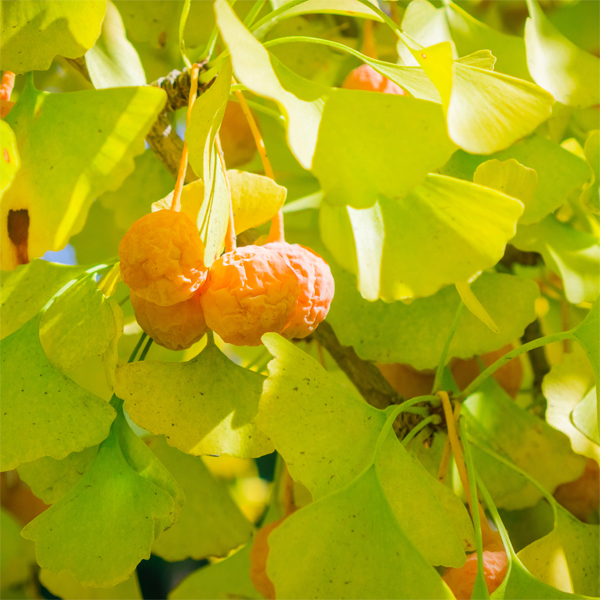When a fruiting female Ginkgo tree grows in your neighborhood, October is an “interesting” time to be outdoors. Ginkgo’s late-autumn leaf coloration is exceptional, as is its tendency to abruptly release all these leaves at once, typically in a single day. Just as this unique tree prepares to shed its fan-shaped, bright yellow foliage, its unusual fruit (borne only on female plants) drops to the ground.
One of the world’s most ancient tree species, Ginkgo is considered to be a “living fossil”, prospering unchanged for thousands of years. Indigenous to Eastern Asia, it has proven resilient and tolerant of pollution and urban conditions, long-lived and thriving in almost any location. Ginkgo seedlings and large-growing cultivars form magnificent shade trees, typically reaching 75 ft. or more at maturity, widely used in gardens worldwide for hundreds of years. Ginkgo nuts and extracts of its leaves and other parts have been used for centuries in many cultures and are widely considered beneficial to human health.
But because female plants produce fruit, they are not well-suited for some locations. Each Ginkgo nut is enclosed by a fleshy, yellowish, ¾” diameter plum-like outer layer (called “sarcotesta”) which, when crushed, emits an extremely unpleasant (butyric acid) odor, comparable to vomit or dog excrement. This pulp is also reported to contain urushiol, the substance in poison ivy that irritates some people’s skin. As the fruit decomposes its odor can persist for many days, so even passing nearby can be an unpleasant experience. But when the outer layer is removed, the edible nut inside is considered a health-enhancing delicacy by many Asian cultures.
Fortunately for those of us with olfactory and skin sensitivities, many Ginkgo trees planted in landscapes are male cultivars; they display all the positive attributes of their female siblings, without the stinky fruit. Among the dozens of cultivars, some of the most popular is ‘Autumn Gold’, ‘Princeton Sentry’ and ‘Saratoga’. And importantly for smaller gardens, a wide selection of slower-growing, even diminutive “dwarf” cultivars are now becoming available, including ‘Jade Butterflies’ (growing to about 12 ft. in 10 years), ‘Chi-Chi’ (about 5 ft.), and ‘Mariken’ which is promoted as reaching only about three feet.
In my gardens, I’ve planted several dwarf-type cultivars, and I’m pleased with how they look. Years ago on a trip to Japan, I tasted Ginkgo nuts, and so I’m also interested in trying a female tree—not readily available on the market. I’m confident I’ll find one from a specialty nursery and that my family and visitors will obligingly tolerate its few odiferous days, provided it’s planted in an appropriate, perhaps downwind, location!







